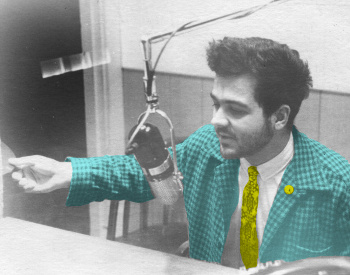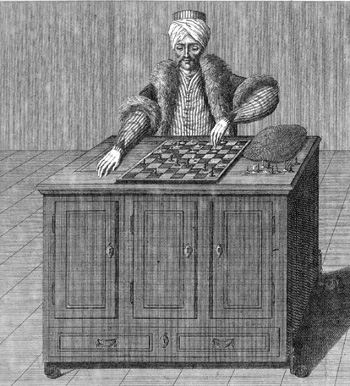Scoring the Hits
January 4, 2012
Management's desire to have
machines make all their decisions for them has roots beyond the modern
computer database systems which have infected
corporations worldwide. When I was working in
radio in the late 1960s (see photograph), I read a story, perhaps
apocryphal, about
music industry executives who were duped into paying for the services of a machine designed to determine the hit potential of
recordings.

The author during his short career as a "Top-40" disk jockey.
This photograph was taken in 1968. Coloring added to the original black-and-white image)
In demonstrations of this wonderful machine, a recording would be played, and the machine would energize lights to indicate whether or not the recording had sales potential. The predictions were fairly good.
It was fairly easy to convince these executives that such a machine was possible. A
Univac computer, featured on
television, predicted that
Eisenhower would win the
1952 presidential election. This hit-detecting machine, however, was a fake. A person inside the box did the actual evaluation. This was a modern day
ruse in the tradition of the
Turk, not to be confused with Amazon's
Mechanical Turk. The Turk was a
chess-playing automaton of the late
eighteenth, and early
nineteenth centuries, that was operated by a man inside the mechanism.

A copper engraving of the Turk, a chess-playing automaton, built in 1770, and operational until 1854. A chess master sat inside the box that also exposed a gear mechanism when the doors were opened.
Source: Karl Gottlieb von Windisch (1783), "Briefe über den Schachspieler des Hrn. von Kempelen..."(Via Wikimedia Commons))
The advent of
powerful computers has heartened
computer scientists to attempt this hit-prediction task. Several years ago,
Brian Whitman and
Tristan Jehan, computer scientists at
MIT, developed software they called
Echo Nest to forecast the hit potential of a recording. They paired listener reviews of recordings with a feature analysis of the recording derived from
signal processing techniques.
Whitman claimed to have predicted the US
Billboard magazine top 10 for several weeks and was quoted in the
Guardian as saying,
"For record company executives, this raises the tantalizing possibility of knowing in advance whether their latest pop act will hit the charts at a strong position.[1]
Music Intelligence Solutions has introduced software it calls
Hit Song Science, and is commercializing it on the
Uplaya web site. Company CEO,
David Meredith, explained that the software discovered that hit songs have similar
lyrics,
harmony,
length,
rhythm and
chord progression. A study by the
Harvard Business School showed that the Hit Song Science software was accurate 8 out of 10 times.[2]
Understandably, companies are unwilling to discuss the intricate details of how their software works, but
academia is fueled by
citations and
publications. A new hit-prediction system has been developed by computer scientists at the
University of Bristol.[3-4] The group is led by
Tijl De Bie, Senior Lecturer (associate professor) in AI at the University of Bristol,
Department of Engineering Mathematics.
As leader of the
Pattern Analysis and Intelligent Systems Group of the
Intelligent Systems Laboratory, De Bie and his students have been investigating
pattern matching for many applications. One of the group's previous successes was in demonstrating how
Twitter can be used for tracking
flu outbreaks in the
UK. They demonstrated that their analysis of 50 million
geolocated tweets offered predictive capability of influenza severity within regions.[5]
In a paper scheduled for presentation on December 17, 2011, at MML 2011, the 4th International Workshop on Machine Learning and Music: Learning from Musical Structure (
Sierra Nevada, Spain), De Bie, along with Yizhao Ni, Raul Santos-Rodriguez and Matt Mcvicar, describe their
machine learning system for hit song prediction.[3]
Since the team is located in the UK, they analyzed the last fifty years of recordings on the
UK top 40 singles chart. Their goal was to differentiate top-five material from the also-rans; that is, those recordings that peaked at just 30-40 on the charts.[3] They used
regression analysis, a technique well known to all
scientists, based on 23 variables, such as
time signature,
tempo,
duration,
loudness and
harmonicity.[3]
Using machine learning techniques, the Bristol team was able to determine how important each of these 23 variables were to a song's hit-potential. This gave a list of
weights for a hit equation,
in which all the factors
f are normalized by their weights
w and summed to give a score. Their equation had a 60% accuracy of predicting whether a song was top-five material, or relegated to the lowest ranks.[3] Chance, of course, is 50%, but in the team's defense, all these songs were already selected as being worthwhile, since they all appeared on the top-forty chart. Thus, the degree of difference between such songs is expected to be small.
The team did need to
bin their data into certain time frames to make even these predictions. Tastes in music change with time, as even a cursory comparison of
Frank Sinatra and
Lady Gaga will show, so their analyses were done using weights that varied in time. They discovered a few interesting facts about
popular music. Dance music became popular in the seventies (
disco lives!), and danceability became an important factor in the eighties.
Ballads with a slower tempo ( 70-89 beats/minute) were more likely to become a hit in the eighties.[3]
The Bristol equation is more accurate in the current era, possibly because record companies are loathe to change any style that sells. From the 1990s to today, 4/4 time seems to be a
sine qua non for a hit song, a fact that's often derided by creative,
independent musicians. The Bristol team also discovered that, on average, songs are becoming louder, and hits are relatively louder than songs at the lower end of the chart.[3]
One trouble with software like this is that song writers might try to "optimize" their offerings to get a higher hit-score, and all music will start to sound the same.[6] Kym Tuvim, an independent singer-songwriter, was quoted on
NPR as saying
"From an artist's standpoint, a songwriter's standpoint, it's horrifying to me... You'll find a decreasing amount of any kind of surprises in music... This just becomes a tool to make that narrowing of the field more accessible."[2]
Then there's this other piece of research, published in
Science in 2006, that says all this doesn't really matter. This paper presents evidence that the success of a song is only partially determined by its
quality. Quality was reflected in the outliers; that is, the best songs rarely did poorly, and the worst rarely became hits. For songs in general, any other result was possible.[7-8]
How could I end an article that mentions both Bristol and hit music without a mention of the
Bristol Stomp? The Bristol Stomp, a 1961 recording by the
Dovells, rose to the second place on the
Billboard magazine Hot 100 singles chart and sold more than a million copies.
References:
- Alok Jha, "Music machine to predict tomorrow's hits - Scientists teach computer how to analyse songs," The Guardian (UK), January 16, 2006.
- by Laura Sydell, "New Music Software Predicts The Hits," NPR, October 12, 2009.
- Joanne Fryer, "Can science predict a hit song?" University of Bristol Press Release, December 17, 2011.
- Yizhao Ni, Raul Santos-Rodriguez, Matt Mcvicar and Tijl De Bie, "Hit Song Science Once Again a Science?" MML 2011, the 4th International Workshop on Machine Learning and Music: Learning from Musical Structure, in Conjunction with the 25th Annual Conference on Neural Information Processing Systems (NIPS 2011), Sierra Nevada, Spain, December 16, 2011.
- Christopher Mims, "How Twitter Could Better Predict Disease Outbreaks," Technology Review, July 14, 2010.
- Will Hit Prediction Software Make It Harder For Creativity To Be Heard? Podcomplex.com Blog, February 8, 2008.
- Predicting music hits - Music industry hits random results, Science Blog, February 14, 2006.
- Matthew J. Salganik, Peter Sheridan Dodds and Duncan J. Watts, "Experimental Study of Inequality and Unpredictability in an Artificial Cultural Market," Science, vol. 311 no. 5762 (February 10, 2006), pp. 854-856.
- Paul Whytock, "Al Gorithm and His Digital Divas. Are They The Next Chart-Toppers?" Electronic Design, 12/20/2011.
Permanent Link to this article
Linked Keywords: Management; machines; computer database system; corporation; radio; apocryphal; music industry; executive; recording; Univac computer; television; Eisenhower; 1952 presidential election; ruse; Turk; Mechanical Turk; chess; automaton; eighteenth century; nineteenth century; chess master; Wikimedia Commons; mainframe; computer; computer scientist; Brian Whitman; Tristan Jehan; Massachusetts Institute of Technology; MIT; Echo Nest; signal processing; Billboard magazine; Guardian; Music Intelligence Solutions; Hit Song Science; Uplaya; David Meredith; lyrics; harmony; length; rhythm; chord progression; Harvard Business School; academia; citation; publication; University of Bristol; Tijl De Bie; Department of Engineering Mathematics; Pattern Analysis and Intelligent Systems Group; Intelligent Systems Laboratory; pattern matching; Twitter; influenza; flu; United Kingdom; UK; geolocation; Sierra Nevada, Spain; machine learning; UK top 40 singles chart; regression analysis; scientist; time signature; tempo; duration; loudness; harmonicity; weighting; weights; data binning; Frank Sinatra; Lady Gaga; popular music; disco; ballad; sine qua non; independent musician; NPR; Science; quality; Bristol Stomp; Dovells; Billboard magazine.